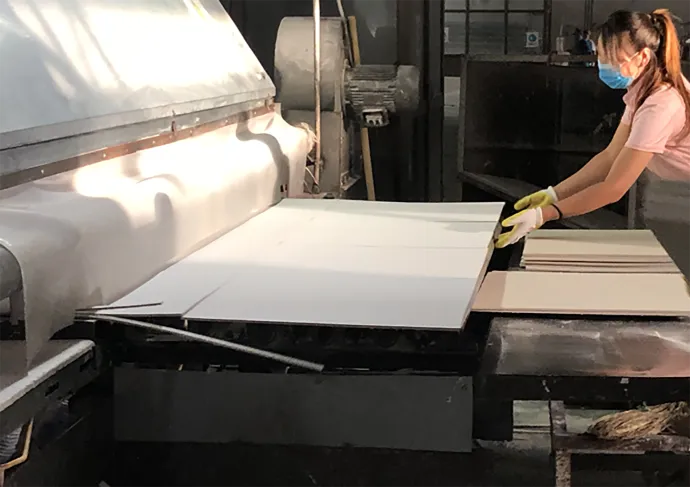- Afrikaans
- Albanian
- Amharic
- Arabic
- Armenian
- Azerbaijani
- Basque
- Belarusian
- Bengali
- Bosnian
- Bulgarian
- Catalan
- Cebuano
- Corsican
- Croatian
- Czech
- Danish
- Dutch
- English
- Esperanto
- Estonian
- French
- German
- Greek
- Hindi
- Indonesian
- irish
- Italian
- Japanese
- Korean
- Lao
- Malay
- Myanmar
- Norwegian
- Norwegian
- Polish
- Portuguese
- Romanian
- Russian
- Serbian
- Spanish
- Swedish
- Thai
- Turkish
- Ukrainian
- Uzbek
- Vietnamese
Kas . 08, 2024 16:51 Back to list
mineral fiber ceiling board specification
Understanding Mineral Fiber Ceiling Board Specifications
Mineral fiber ceiling boards are widely used in both residential and commercial construction due to their excellent acoustic properties, fire resistance, and aesthetic versatility. When selecting the right mineral fiber ceiling board, it's crucial to understand the specifications that govern their performance and installation. This article aims to provide a comprehensive overview of the key specifications associated with mineral fiber ceiling boards.
Composition and Materials
Mineral fiber ceiling boards are primarily composed of a blend of natural and synthetic fibers, typically including mineral wool, fiberglass, and various additives. The composition can greatly influence the board's durability, sound absorption, and fire resistance. The most common materials used include
- Mineral Wool This material offers superior sound insulation and is fire-resistant, making it an ideal choice for high-traffic areas. - Fiberglass Known for its lightweight property and corrosion resistance, fiberglass-enhanced boards often have a higher performance rating in moisture-prone environments. - Additives Various additives are used to enhance properties such as mold resistance, color, and texture.
Performance Features
1. Acoustic Properties One of the main advantages of mineral fiber ceiling boards is their ability to absorb sound. Specifications often detail the Noise Reduction Coefficient (NRC), which measures how much sound is absorbed by the material. A higher NRC rating indicates better sound absorption, which is essential for environments like offices, schools, and restaurants.
2. Fire Rating Safety is a top priority in any construction project. Mineral fiber ceiling boards typically have a Class A fire rating, which means they are highly resistant to flames and can help prevent the spread of fire. Specifications will often provide details on the board's fire resistance ratings, which are crucial for compliance with building codes.
mineral fiber ceiling board specification

3. Moisture Resistance In areas susceptible to high humidity, moisture-resistant mineral fiber boards are essential. These boards are manufactured with specific additives that prevent mold and mildew growth, which could compromise indoor air quality.
4. Thermal Insulation The thermal performance of mineral fiber ceiling boards is another important specification. These boards help regulate indoor temperature and can contribute to overall energy efficiency. Understanding the thermal resistance, or R-value, of the boards can help in making informed choices.
Aesthetic Options
Mineral fiber ceiling boards come in various textures, colors, and shapes, allowing for creative design while maintaining functionality. Common textures include smooth, fissured, and textured patterns, each providing different acoustic properties and visual appeal. The choice of color can also enhance the aesthetic quality of a space.
Installation Considerations
The installation of mineral fiber ceiling boards requires careful attention to specifications regarding weight and support requirements. The boards are usually lightweight, allowing for easier handling and installation; however, compliance with the load-bearing capacities of the ceiling grid is crucial. Proper installation guidelines must also be followed to maintain noise and thermal performance.
Conclusion
In summary, mineral fiber ceiling boards offer a multitude of benefits when chosen correctly according to their specifications. Understanding the composition, performance features, aesthetic options, and installation requirements is essential for achieving optimal results in construction projects. By choosing high-quality mineral fiber ceiling boards, one can enhance the aesthetic appeal of a space while ensuring safety, comfort, and sustainability.
-
Transform Interiors with PVC Gypsum Ceiling: A Stylish, Durable, and Moisture-Resistant SolutionNewsMay.19,2025
-
The Smart Interior Upgrade: Discover the Durability and Versatility of Gypsum Ceiling Access Panel SolutionsNewsMay.19,2025
-
The Smart Choice for Interior Design: Discover the Value of PVC Gypsum Ceiling SolutionsNewsMay.19,2025
-
Mineral Fiber Ceiling Tiles: The Smart Blend of Performance and AestheticsNewsMay.19,2025
-
Mineral Fiber Ceiling Tiles: The Superior Choice Over Gypsum for Sound and Fire SafetyNewsMay.19,2025
-
Mineral Fiber Ceiling Tiles: Eco-Friendly Strength and Style for Every CeilingNewsMay.19,2025







